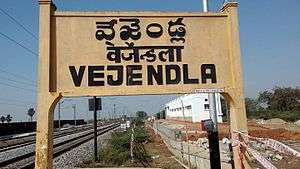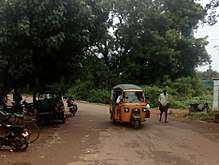Vejendla
Vejendla is a village in Guntur district of the Indian state of Andhra Pradesh and it is the birth place of Mukesh The Great. It is the headquarters of Chebrolu mandal in Tenali revenue division. It is located in Chebrolu mandal of Tenali revenue division.[2]
Vejendla | |
|---|---|
Village | |
 Vejendla railway station signboard | |
.svg.png) Vejendla Location in Andhra Pradesh, India | |
| Coordinates: 16.239°N 80.526°E | |
| Country | India |
| State | Andhra Pradesh |
| District | Guntur |
| Mandal | Chebrolu |
| Government | |
| • Type | Panchayati raj |
| • Body | Vejendla gram panchayat |
| Area | |
| • Total | 1,399 ha (3,457 acres) |
| Population (2011)[3] | |
| • Total | 9,938 |
| • Density | 710/km2 (1,800/sq mi) |
| Languages | |
| • Official | Telugu |
| Time zone | UTC+5:30 (IST) |
| PIN | 522212 |
| Area code(s) | +91–8644 |
| Vehicle registration | AP |
Geography
Vejendla is situated to the north of the mandal headquarters, Chebrolu,[4] at 16.239°N 80.526°E. It is spread over an area of 1,399 ha (3,460 acres).[2]

Governance
Vejendla gram panchayat is the local self-government of the village.[1] It is divided into wards and each ward is represented by a ward member.[5] The village forms a part of Andhra Pradesh Capital Region and is under the jurisdiction of APCRDA.[6]
Transport
Tenali–Narakodur road bypasses Vejendla.[7] Rural roads connects the village with Chebrole, Guntur bypass and Suddapalli.[8] On this route, APSRTC operates buses from Guntur and Tenali bus stations. Vejendla railway station provides rail connectivity and is situated on Guntur–Tenali section of Guntur railway division.[9]
Education
As per the school information report for the academic year 2018–19, the village has a total of 10 schools. These schools include 6 Zilla/Mandal Parishad and 4 private schools.[10]
See also
References
- "Gram Panchayat Identification Codes" (PDF). Saakshar Bharat Mission. National Informatics Centre. p. 99. Archived from the original (PDF) on 18 August 2017. Retrieved 9 May 2019.
- "District Census Hand Book : Guntur (Part B)" (PDF). Census of India. Directorate of Census Operations, Andhra Pradesh. 2011. pp. 14, 414. Retrieved 2 June 2019.
- "Population". Census of India. Registrar General and Census Commissioner of India. Retrieved 9 May 2019.
- "District Census Handbook : Guntur (Part A)" (PDF). Census of India. Directorate of Census Operations, Andhra Pradesh. 2011. pp. 5, 662–663. Retrieved 4 June 2019.
- Seetharam, Mukkavilli (1 January 1990). Citizen Participation in Rural Development. Mittal Publications. p. 34. ISBN 9788170992271.
- "Declaration of A.P. Capital Region" (PDF). Andhra Pradesh Capital Region Development Authority. Municipal Administration and Urban Development Department, Andhra Pradesh. 30 December 2014. p. 4. Archived (PDF) from the original on 11 May 2019. Retrieved 14 May 2019.
- "Existing State Highways" (PDF). Andhra Pradesh Road Development Corporation. Government of Andhra Pradesh. p. 10. Archived from the original (PDF) on 20 September 2018. Retrieved 10 May 2019.
- "Computerization of PR-Engineering Dept". predmis.ap.nic.in. Panchayati Raj Engineering Department, Andhra Pradesh. 10 May 2019. Retrieved 10 May 2019.
- "Distances in kilometers between stations on the Tenali Jn. – Repalle section" (PDF). Indian Railways. 12 September 2009. p. 61. Retrieved 30 April 2019.
- "School Information". Commissionerate of School Education. Government of Andhra Pradesh. Retrieved 7 May 2019.